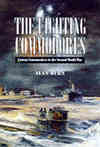The Fighting Commodores
Convoy Commodores in the Second World War
Burn, Alan
1999, United States Naval Inst.
ISBN 1557502838
Hardcover, 262 pages, 16 b&w photographs, 2 maps
| Type. | General History book |
| Pros. | Some good information about convoys |
| Cons. | Some errors and a notable bias |
| Rating. |  |
 Shortly after submitting the first draft of this book to the publisher, the author suffered a debilitating stroke, and was unable to work further on his manuscript. The publisher decided to release the book in its draft format. Because of this factor, it is difficult to know whether the book's errors and insufficiencies would have been corrected in a final draft.
Shortly after submitting the first draft of this book to the publisher, the author suffered a debilitating stroke, and was unable to work further on his manuscript. The publisher decided to release the book in its draft format. Because of this factor, it is difficult to know whether the book's errors and insufficiencies would have been corrected in a final draft.
While overall a valuable overview of convoys and the senior naval officers called out of retirement to command them, a few factors diminish the book's usefulness. One is its lack of bibliography. Many times the chapter notes provide further explanation of a point in the text, but not its source. Considering the range of material covered, the detailed data presented, and the accusations leveled (see below) one would like to know which sources the author used. There is an index, but it is far from complete.
Some misspellings of names occur, wrong ranks are attributed to U-boat commanders, and some sinkings of convoy vessels are attributed to the wrong U-boat. Once again, it is possible these errors would have been corrected had the author had the opportunity to revise his manuscript.
However, a bias on the part of the author constitutes a real blow against the book's credibility. Throughout the book the author returns constantly the sinking of the Athenia, which he uses as symbolic of the "ruthlessness" of the German enemy, stating for example that Lemp "sank the Athenia in flagrant disobedience of orders and with total disregard for the 1103 passengers, neutral as well as British, who were on board… he left them to drown…" He also states "a lot has been written about the U-boat officers and crews, their training, morale, discipline, courage, loyalty and efficiency, and some of this is justified. But there were some notable exceptions." After providing a few "exceptions", among them the previously quoted passage about Lemp, he ends each paragraph with phrases like "So much for discipline and example." "So much for volunteers and morale." "So much for courage."
These paragraphs turn out to have a purpose. He uses them as a platform from which to launch accusations that the demise of the Fidelity, sunk by U-435, was actually a Peleus-like incident, suggesting "The Germans involved in the Peleus massacre were brought to book because two men survived and got ashore. Perhaps not a single person survived from Fidelity because a similar massacre was more efficiently carried out and no one survived."
While he quotes radio traffic between U-435 and BdU, reading between the lines and finding a subtext that "proves" this possibility, his apparently heavy reliance on Padfield's biography of Dönitz, which we have found to be very biased (see our review), leads one to believe this accusation is itself founded on bias rather than objective research.
Overall this book is a strange mixture, alternating in tone between dispassionate reporting (on the Allies) and bitter reproach (of the Germans), and providing essentially accurate overviews marred by incorrect details. Once again, it is possible that all these issues would have been resolved if the author's health had allowed. However, in its present form, it is difficult to recommend this book as a whole. Rather, can be viewed as a good source for learning about convoys and their commanders and crews, but a poor source for learning about convoy battles and U-boats.
Review written by Tonya Allen.
Published on 4 Dec 1999.
Purchase information: (info) Get The Fighting Commodores now at amazon.co.uk
Get The Fighting Commodores now at amazon.co.uk
Return to our main review page.



